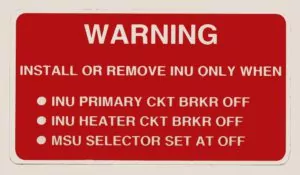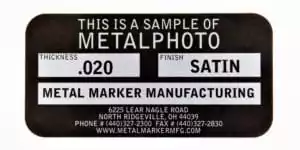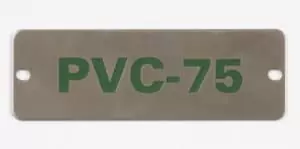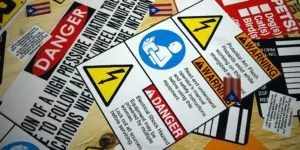Millions of people rely on elevators each and every day to get them where they need to be. Those elevators have to be inspected and maintained on a regular basis to keep them safe for use. One of the key elements in elevator inspections are elevator code data plates.
Application
Metal nameplates used in this industry are typically referred to as elevator code data plates. They ensure that an elevator is up to code on all relevant standards.
Data plate codes are a major part of elevator inspections and testing.
If an elevator is modified, adjusted, or modernized; it must be recorded and marked. These changes are primarily referred to as alterations.
Safety & Warning Signs
ASME A17.1
The American Society of Mechanical Engineers is an organization which provides many resources and services including setting industry standards.
In their A17.1 guidelines, they strictly call out the requirement for elevators to be marked with a metal code data plate.
This data plate must be marked with up-to-date information, and must be in plain view for inspection. The rules also specify locations it can be attached, either the controller or main line disconnect.
(https://blog.ansi.org/2018/02/asme-a17-elevator-safety-standards/)
Max Occupancy Signs
Have you ever been in an elevator that was too crowded? If it gets off to a sluggish start your mind might wander as to whether or not it can support so many people at once.
You might have also noticed a sign that identifies a total weight or number of passenger limit. These max occupancy limit capacity placards are important, and provide safety information at a glance.
Fire Safety/Emergency Signs
Every elevator you ever set foot in should have clear and prominent identification in regards to safety. This especially includes fire and emergency signage. These markers provide clear instructions in the event of an emergency.

For example, a sign might instruct fire fighters on the elevator operation controls they have access to during a fire. Many lifts also include instructions for passengers. This might include a map showing the quickest route to a stairwell or emergency exit.
Other Applications
Other methods of indoor transit utilize metal data plates for identification as well. Any mechanical form of transportation has its own set of guidelines and requirements.
A few examples include:
- Freight elevators
- Escalators
- Dumbwaiters
- Material Lifts
- Moving Walkways
- and Many More!
Materials
The two most commonly used materials for elevator data plates are stainless steel and aluminum. These materials offer the highest level of durability and useful life. They will not need to be replaced for many years, whether they are in a control box or visible to passengers.
Material selection is important if your organization is going to adhere to ASME guidelines. The A17.1 Section 8.9.3 is all about materials. It states that the code plate must stay legible and remain permanent.
(https://blog.ansi.org/2018/02/asme-a17-elevator-safety-standards/)
The only way to guarantee this is with a plate made from a metal substrate, and utilizing a durable marking process.
Processes
Photo Anodization
The most used process for data code plates is photo anodization.
Specific data code information may vary from state to state based on regulation, however this process can accommodate any specs.

It creates an incredibly durable design which has the appearance of printed ink, but without the concern it will wear. The process embeds the image inside layers of a special anodized aluminum material.
With this process rated for 20+ years durability outdoors in all weather conditions, these tags can last a very long time when used for elevator nameplates.
Etching
The etching process is one of the marking methods mentioned by name in the ASME standards as an option for elevator code plates.
By marking with either a laser or chemical process, a fully custom design can be applied to a metal substrate.

After the etching is finished, a solid color infill can be added to make the design stand out. However, this color will be prone to fading and wear over time.
Printing (Labels)
What about other warning labels and signs? Custom labels and decals are frequently used for marking safety signs and warnings in a wide array of applications.
Elevators and especially other transportation methods such as escalators feature bright warning labels.

These markers make for great safety signs due to their bright colors. They are very easy to read, and stand out with bright colors and symbols.
While vinyl or poly decals work great for a safety warning label, they are not a permanent solution, and will wear/fade over time.
Wrap-Up
Elevator tags are a necessary part of servicing and inspecting these vital transportation methods. The only way to prevent accidents and mechanical issues is with proper identification and inspection.
Ensure your organization is up to code with custom metal data plates.
Contact Us
Need to get elevator code data plates for your inspection team? Give us a call at 1-800-428-0095 to request your FREE quote today.
Our knowledgeable customer service representatives are ready to assist you in the production of your elevator data tags.